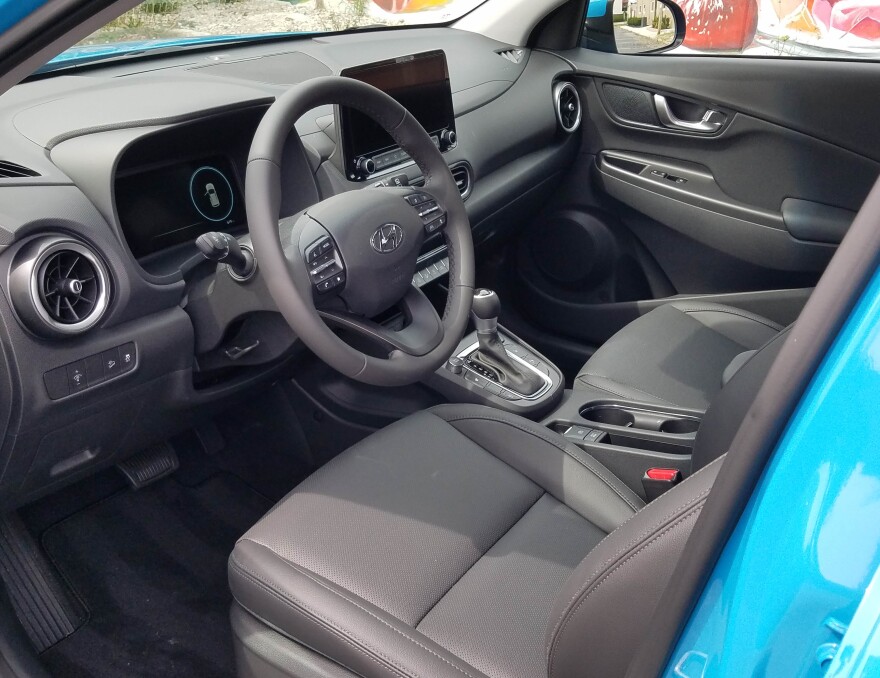Roughly three years had passed since I last tested Hyundai’s small crossover, the Kona. I’d almost forgotten just how much fun it is.
That can’t be said for all the little crossovers, plus Kona offers AWD and remains friendly to your bank account.
For 2022 Kona’s chassis and rear suspension are strengthened, which helps ride, and the crossover grows by 1.6 inches while its exterior styling is freshened a bit. Kona was already a cute ute, offering a two-tone paint scheme like Mini. It comes in some fun colors, too. My tester was a bright Teal Isle blue reminiscent of a toddler’s plastic wading pool.
This time I drove the top-level Limited with AWD, which ensured the Kona packed more power — not that its base 147-horse 2.0-liter I4 is a sissy. It’ll move in Sport mode.
But this top-end model packs a 1.6-liter turbocharged I4 that delivers 195 horses with an identical torque rating. That’s 20 more horses than the 2021 model. The upshot? Kona sprints away from stoplights well in Normal drive mode (one of three), but turns into a party car in Sport mode when the shift patterns emphasize low-end power.
Yet the engine, even with an AWD system to support, gets respectable gas mileage. The EPA rates this turbo at 27 mpg city and 32 mpg highway. I got 27 mpg in about 80% city driving.
Aiding Kona’s pep is its 7-speed Ecoshift dual clutch transmission, which makes good use of the power, giving the Hyundai smooth yet zippy acceleration and a quality feel. Lower trim levels now use a CVT with the 2.0-liter engine.

Beyond the welcomed power boost, everything Kona had going for it three years ago remains.
Handling is quick and easy with little lean in turns. Parking is a breeze and slipping in and out of tight highway traffic feels like blasting around a slot car track. Traction is stout with the AWD and Goodyear R19 rubber underneath. Smaller tires are standard on lower trims. Note too that AWD is $1,500 extra on the SEL and higher trim levels.
With Kona you feel you control the car, not the other way around. It helps that its lane departure system can be disengaged with the press of a button too to stop an irritating chime. Yet, the crossover still pushes some back toward the lane’s center due to that system. I’d prefer the driver be given full control via that on-off button.
Ride is decent for a short-wheelbase crossover, with that strengthened rear multi-link suspension doing a solid job of handling southeast Wisconsin’s crumbling roads and jarring expansion joints. In town and on railroad tracks you’ll feel those bumps, but they don’t pound the interior occupants as in some small vehicles.
Also, unlike some small crossovers, Kona manages to be high-value but never feels cheap.
The interior is fairly quiet for its size and price, so you can hear the fancy Harmon Kardon stereo that’s standard in this Limited model. There’s some wind noise, but road noise is well dampened.
Kona’s cockpit also is simply elegant while being highly functional.

The Limited comes with twin 10.25-inch screens, one a digital number for the instrument panel and the other rising out of the dash’s center for infotainment purposes. It’s a touchscreen and simple enough to use, plus features navigation so you don’t have to futz with hooking up your cell’s GPS.
There’s a wireless phone charger too in a cubby at the base of the center stack. It’s a bit touchy, so be sure the light there comes on to signal you’re actually charging the phone.
Kona’s dash matches the dark gray perforated leather seats and most trim is a flat or non-glare gray. That’s great on the console as it removes the threat of sun reflecting off a chrome surface. The trim extends to the door panels while a gloss black trim surrounds the info screen and the air vents at each end of the dash feature satin chrome, same as the door releases.
Apple Car Play and Android Auto also are standard.

Despite being an entry-level vehicle, Hyundai doesn’t chintz on safety equipment. The SEL, Limited and N Line models come with a full safety suite. That includes front collision avoidance assist, lane keeping with lane follow, blind-spot collision avoidance assist, safe exit warning, downhill brake control, hill start assist, tire pressure monitor and driver attention warning. Similar features still cost extra in some vehicles, including a few luxury models. Sight lines also are good here with a very airy feeling cockpit.
Smart cruise control is standard on the Limited, as are heated front seats. Speaking of which, these seats are shaped to give reasonable side and hip support, but do feel a tad hard, so they might be a little tough on a long trip.
Rear seat headroom is fine and legroom not bad for average size adults. Taller folks may find legroom a bit tight, but Hyundai did manage to find an additional half-inch of rear legroom for 2022 models.
I make no secret of my love for hatchbacks and, well, crossovers are basically taller hatchbacks. This hatch is manual to keep costs down, and includes a rear window wiper — a must for Wisconsin winters.
Cargo space behind the split, fold-down rear seats is reasonable at 19.2 cubic feet. Remember that many mid-size and smaller sedans often only offer 14-16 cubic feet of trunk room. Fold the rear seats down and there’s 45.8 cubic feet of space, which is about enough to hold a college dorm room worth of stuff.

Pricing is impressive still for Kona with a base SE model starting at $22,175, including delivery. Again, that gets you the less powerful engine, but it can still be fun in Sport mode.
Move up to the SEL model, an attractively equipped mid-level offering and the price is $23,975. Remember you can add AWD for $1,500. The SEL improves tire size from 16 to 17 inches, adds heated outside mirrors, rear privacy glass, satellite radio, and the safety suite.
The tested Limited AWD with its leather seats and fully loaded equipment level starts at $31,175 with delivery. This only added $155 worth of carpeted floor mats to register a $31,330 final sticker.
Folks aiming for a sportier model now can choose an N Line, starting at $28,085. It includes the same turbo I4 as in the Limited, 18-inch wheels, an 8-way power driver’s seat, wireless phone charger, the bigger screen, automatic climate controls and heated sport seats.
However don’t confuse it with the Kona N, which debuts this fall and packs a crazy 276-horsepower engine, an 8-speed automatic, Pirelli 19-inch performance tires, a special corner carving differential, active sport exhaust and electronically controlled suspension. Pricing is yet to be announced.
And if that’s not enough to consider, consider this: there’s a Kona Electric starting at $34,000 — a price cut from last year. It has a range of 258 miles and the equivalent of 201 horsepower from its electric motor. It has been Kelly Blue Book’s EV of the Year since 2018 when it was launched. That’s a strong recommendation.
OK, that’s the skinny on the new Kona. The original was fun and this one’s funner, uh, more fun!
Overview: 2022 Hyundai Kona Limited AWD
Hits: Sharp looks, peppy engine, good handling, AWD, 3 drive modes, and quiet interior. Fine digital instrument panel, big info screen, smart cruise control, sunroof, wireless phone charger, hatch with wiper, heated seats, fancy stereo, good sight lines and you can turn off lane departure assist.
Misses: Seats are a tad hard and tall folks may wish for more rear legroom, although it has improved slightly.
Made in: Ulsan, South Korea
Engine: 1.6-liter turbo I4, 195 hp
Transmission: 7-speed dual-clutch automatic
Weight: 3,106 lbs.
Wheelbase: 102.4 in.
Length: 165.6 in.
Cargo: 19.2-45.8 cu.ft.
MPG: 27/32
Base Price: $31,175 (includes delivery)
Invoice: $29,544
Major Options: Carpeted floor mats, $155
Test vehicle: $31,330
Sources: Hyundai, Kelley Blue Book
Editor's Note: Mark Savage's auto review column, Savage On Wheels, looks at a new vehicle every week and tells consumers what’s good, what’s not so good, and how the vehicle fits into the marketplace.







